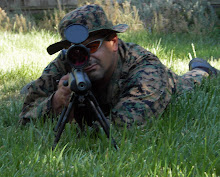One question that I get asked a lot is:
- How do you know when a star is perfectly focused?
When attempting to focus on a star, the range of focus can be somewhat large, meaning that the difference between perfect focus and out of focus can be very visually challenging to discerne. This is true of visual astronomy, but even more difficult and time consuming in astrophotography.
There are many ways to obtain a perfect focus, one of my favorites is to use a tool called a Bahtinov mask, which fits on the front of your telescope over the aperture.
If you are performing visual focusing with the mask, just point the telescope at a bright star and you will see diffraction spikes emanating from the star as you look into your objective lens. You can then adjust the focus of the telescope to create a perfect diffraction image, where the spikes are completely in alignment.
Here is an image of what the alignment should look like:
In the image above, you notice three diffraction spikes per side of the star, the objective is to align the center spike so it is equidistant from the two outer spikes. If it is closer to either side, then the image is out of focus. This is a very simple procedure if you are looking to focus for visual astronomy, however if you are attempting to perform this for astrophotography, this is where some challenges emerge.
Here are some tips that I use when attempting to focus with the mask on a live camera image:
Getting good diffraction spikes:
1) If you are attempting focus with a camera and Bahtinov mask, you will need to increase the time of the image to ensure that you capture enough photons to obtain a good view of the star and diffraction spikes. The image above was taken with 30 seconds of exposure, when I took images of 10 and 20 seconds, the diffraction spikes were almost not visible. Experiment to find the right time for your imaging setup to capture enough photons to enable you to see the diffraction spikes clearly, once you see them clearly, note the imaging time and move on. Spending more time per image than absolutely neccessary to see the diffraction spikes is not going to help you achieve better results.
Imaging focus:
2) If you choose a 'focus' routine in your imaging software (such as Maxim DL), the software will have the camera initiate a continuous loop of photos for the duration of imaging time you set (eg: 30 second images), spaced apart by a time roughly equal to the amount of time necessary to download the photo from the camera to the PC. I find this to be less than optimal in most cases as the loop doesn't allow enough time between photos and downloads to perform modifications to focusing. The lack of delay in focusing, may make you waste a bunch of time making 'blind' focus changes thereby increasing the time spent focusing.
Instead I choose to shoot a single photo, see what focus modifications need to be made, make the adjustments and shoot another single photo. I find that this process is generally much faster than trying to work within the 'focus' routine.
For example, using the 'focus' routine I will spend roughly 15 minutes attempting to gain perfect focus, when using the single shot method, I usually have focus within 5 minutes. (given 30 second image captures)
Reducing setup time:
3) Once you find great focus on your camera, you may want to remove the camera and insert an eyepiece with a focusing ring into the telescope. The concept here is to move the eyepiece around until you have a very clear picture of the stars without changing the actual focus of the telescope, essentially giving you the same image visually that you had while taking photos. Once you obtain focus, you then lock the focusing ring in place around the barrel of the eyepiece. This makes the eyepiece parfocal with the camera, allowing you to use your eyepiece to move between objects to image without having to repeat the focusing of your camera.
When you have a parfocal eyepiece, it can be used to gain an initial setup for your telescope without moving your focus, making it faster to get to the fun stuff and away from additional setup time.
In summary:
The Bahtinov mask can be a very effective tool for obtaining great focus, leaving you with very tight round stars and clear shots of your intended target. Taking the time to learn how to most effectively use it in your setup routine can shorten time to imaging, which is time well spent in my book.
Notes:
1) In order to facilitate removal of the mask after focusing and not getting fingerprints on the primary objective lens of my SCT, I placed a couple of small zip-ties on the edges of the mask, they are not in the light gathering path so they do not affect the images and they make the removal of the mask a very simple task in the dark. (Photo below)
Sunday, October 9, 2011
Subscribe to:
Posts (Atom)


